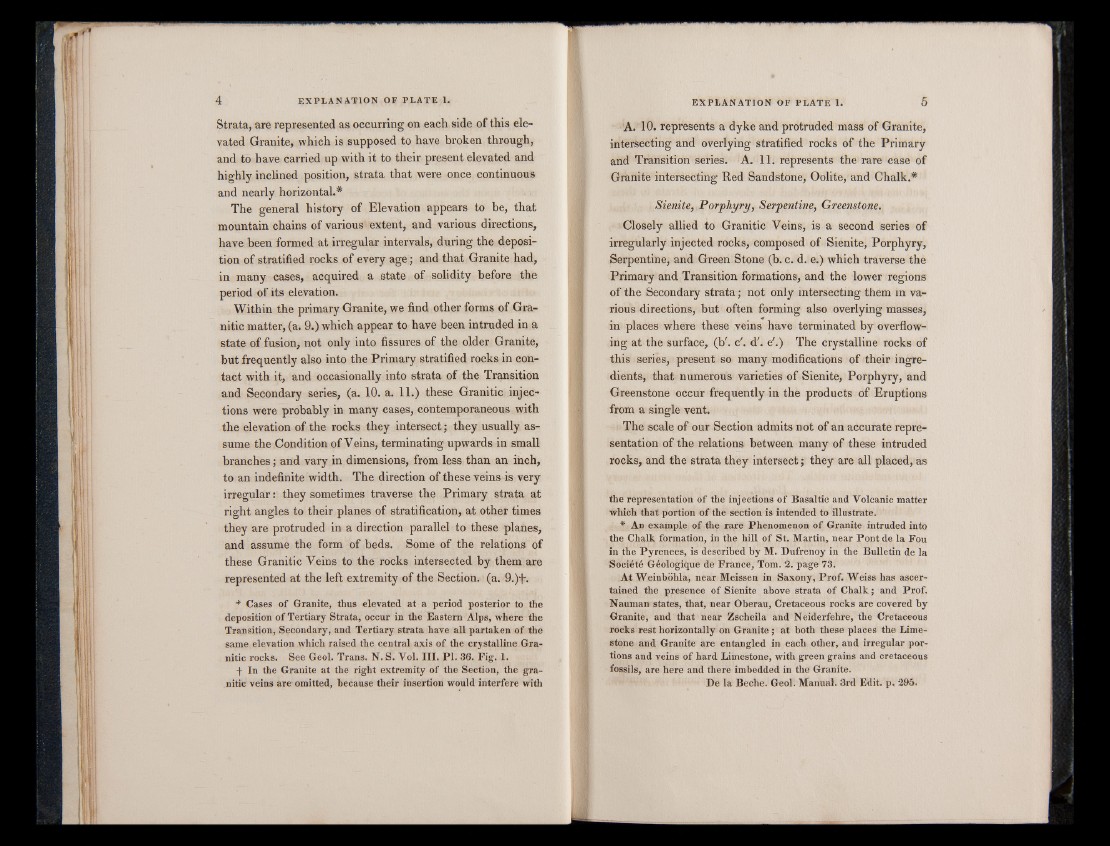
Strata, are represented as occurring on each side of this elevated
Granite, which is supposed to have broken through,
and to have carried up with it to their present elevated and
highly inclined position, strata that were once continuous
and nearly horizontal.*
The general history of Elevation appears to be, that
mountain chains of various extent, and various directions,
have been formed at irregular intervals, during the deposition
of stratified rocks of every age; and that Granite had,
in many cases, acquired a state of solidity before the
period of its elevation.
Within the primary Granite, we find other forms of Granitic
matter, (a. 9.) which appear to have been intruded in a
state of fusion, not only into fissures of the older Granite,
but frequently also into the Primary stratified rocks in contact
with it, and occasionally into strata of the Transition
and Secondary series, (a. 10. a. 11.) these Granitic injections
were probably in many cases, contemporaneous with
the elevation of the rocks they intersect; they usually assume
the Condition of Veins, terminating upwards in small
branches; and vary in dimensions, from less than an inch,
to an indefinite width. The direction of these veins is very
irregular: they sometimes traverse the Primary strata at
right angles to their planes of stratification, at other times
they are protruded in a direction parallel to these planes,
and assume the form of beds. Some of the relations of
these Granitic Veins to the rocks intersected by them are
represented at the left extremity of the Section, (a. 9.)f.
* Cases of Granite, thus elevated at a period posterior to the
deposition of Tertiary Strata, occur in the Eastern Alps, where the
Transition, Secondary, and Tertiary strata have all partaken of the
same elevation which raised the central axis of the crystalline Granitic
rocks. See Geol. Trans. N. S. Vol. III. PI. 36. Fig. 1.
j- In the Granite at the right extremity of the Section, the granitic
veins are omitted, because their insertion would interfere with
A. 10. represents a dyke and protruded mass of Granite,
intersecting and overlying stratified rocks of the Primary
and Transition series. A. 11. represents the rare case of
Granite intersecting Red Sandstone, Oolite, and Chalk.*
Sienite, Porphyry, Serpentine, Greenstone.
Closely allied to Granitic Veins, is a second series of
irregularly injected rocks, composed of Sienite, Porphyry,
Serpentine, and Green Stone (b. c. d. e.) which traverse the
Primary and Transition formations, and the lower regions
of the Secondary strata ; not only intersecting them in various
directions, but often forming also overlying masses,
in places where these veins have terminated by overflowing
at the surface, (b'. c'. d'. e'.) The crystalline rocks of
this series, present so many modifications of their ingredients,
that numerous varieties of Sienite, Porphyry, and
Greenstone occur frequently in the products of Eruptions
from a single vent.
The scale of our Section admits not of an accurate representation
of the relations between many of these intruded
rocks, and the strata they intersect ; they are all placed, as
the representation of the injections of Basaltic and Volcanic matter
which that portion of the section is intended to illustrate.
* An example of the rare Phenomenon of Granite intruded into
the Chalk formation, in the hill of St. Martin, near Pont de la Fou
in the Pyrenees, is described by M. Dufrenoy in the Bulletin de la
Société Géologique de France, Tom. 2. page 73.
At Weinbohla, near Meissen in Saxony, Prof. Weiss has ascertained
the presence of Sienite above strata of Chalk ; and Prof.
Nauman states, that, near Oherau, Cretaceous rocks are covered by
Granite, and that near Zscheila and Neiderfehre, the Cretaceous
rocks rest horizontally on Granite ; at both these places the Limestone
and Granite are entangled in each other, and irregular portions
and veins of hard Limestone, with green grains and cretaceous
fossils, are here and there imbedded in the Granite.
De la Beche. Geol. Manual. 3rd Edit, p, 295.